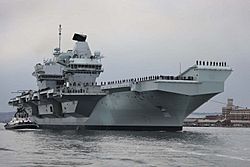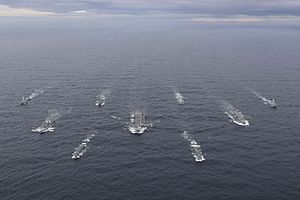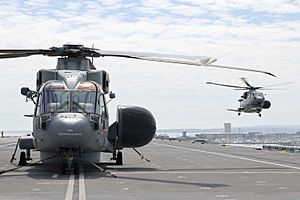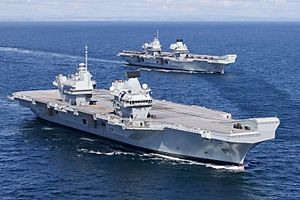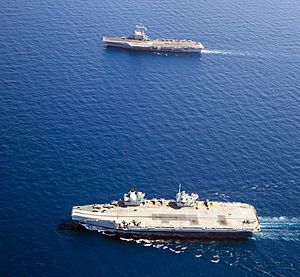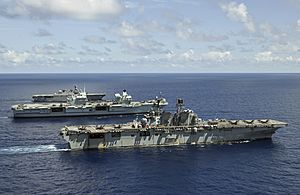United Kingdom Carrier Strike Group 21 facts for kids
The United Kingdom Carrier Strike Group 21 (CSG21) was a powerful group of British-led naval ships. It sailed on a mission called Operation Fortis from May to December 2021. This journey showed that the British Government was focusing more on the Indo-Pacific region for defense and foreign policy.
This was the first major mission for the new Queen Elizabeth-class aircraft carriers. It was also the first time the full UK Carrier Strike Group had been on an operational mission since 2011. The deployment included the largest number of F-35 fighter jets ever used in one group. It was also the biggest group of fifth-generation fighter jets on a carrier anywhere in the world at that time. HMS Queen Elizabeth carried the most people since it started service. The group also had the most Royal Navy helicopters deployed in over 10 years.
Contents
What is a Carrier Strike Group?
For almost 40 years, the United Kingdom did not have its own fully ready carrier strike group. It also did not have any aircraft carriers at all after 2014. That was when the last Invincible-class carrier, HMS Illustrious, was taken out of service. This happened three years before the two new carriers were ready.
The UK Carrier Strike Group was put back together in February 2015. Over the next few years, new commanders were appointed. HMS Queen Elizabeth officially joined the fleet on December 7, 2017. After that, it started training and testing at sea. This included practicing with fighter jets off the coast of the US.
In September 2019, the UK Carrier Strike Group gathered for the first time. Ships like HMS Dragon, HMS Northumberland, and RFA Tideforce joined together. They took part in NATO's Exercise Cutlass Fury near Canada. This exercise was also the first time British F-35 jets landed on the Queen Elizabeth's deck.
In September 2020, the full carrier strike group came together. It included nine surface ships and an air wing. This happened in the North Sea as part of NATO's Exercise Joint Warrior. The group was ready for its first mission by January 4, 2021.
Getting Ready for Deployment
HMS Queen Elizabeth left HMNB Portsmouth on March 1, 2021. It spent time in the English Channel and the Irish Sea for training. The ship also practiced with helicopters from the Royal Air Force and the British Army's Army Air Corps.
Then, the carrier sailed to Loch Long in Scotland. It picked up weapons at the Northern Ammunition Jetty. This jetty had been made bigger to fit the ship. The ship stayed there for five days in March. While in Scotland, a special service was held on board. It honored HMS Dasher, an escort carrier from Second World War that sank in 1943.
In April, the Royal Navy started giving COVID-19 vaccines to the strike group members. The Secretary of State for Defence, Ben Wallace, said that all sailors would get two vaccines before leaving.
USS The Sullivans from the US Navy left its base on April 19. It sailed to the UK to join the group. Between April 26 and 28, 10 F-35B jets from the United States Marine Corps's Marine Fighter Attack Squadron 211 (VMFA-211) arrived at RAF Lakenheath. Their pilots had already started a 14-day isolation period due to the COVID-19 pandemic. On May 2, the first F-35B fighters from VMFA-211 joined HMS Queen Elizabeth.
820 Naval Air Squadron practiced with Sting Ray torpedoes before leaving. Their three Crowsnest radar helicopters and four anti-submarine Merlin Mk2 helicopters joined the Queen Elizabeth on April 27. The group's four Lynx Wildcat helicopters from 815 Naval Air Squadron joined the Royal Navy escort ships on May 1. No. 617 Squadron RAF and their 8 F-35B fighters started flying from RAF Marham to HMS Queen Elizabeth on May 3. The last British aircraft, three Merlin Mk4s from 845 Naval Air Squadron, joined RFA Fort Victoria later that day.
Exercise Strike Warrior
The ships of the strike group left their home ports on May 1. They sailed to Scotland for their final exercise before deployment. This exercise was called Strike Warrior. It took place between May 8 and 19. A total of 31 ships, 3 submarines, 150 aircraft, and 13,400 people from 10 nations took part.
During the exercise, two MV-22B Osprey aircraft landed on HMS Queen Elizabeth for the first time. Also, a Crowsnest radar-equipped Merlin helicopter launched from a Queen Elizabeth-class aircraft carrier for the first time. British F-35 fighters also fired Advanced Short Range Air to Air Missiles. This was the first time British jets fired missiles at sea in 15 years.
Final Departure from the UK
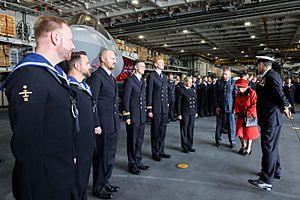
After Exercise Strike Warrior, the ships returned to port to refuel and resupply. On May 19, HMS Queen Elizabeth met its sister ship HMS Prince of Wales at sea. They sailed together for the first time and took photos before going their separate ways.
On May 21, Prime Minister Boris Johnson visited HMS Queen Elizabeth. He toured the ship and spoke to the crew. The next day, Queen Elizabeth II also visited the ship and talked to the crew members.
HNLMS Evertsen from the Netherlands left on May 22. HMS Defender and HMS Kent also sailed from Devonport that day. HMS Queen Elizabeth left Portsmouth on the evening of May 22, along with USS The Sullivans. The rest of the ships left on May 23 and 24. Once the group left the UK, its command passed to the Chief of Joint Operations.
The Deployment Journey
The plan for the 28-week mission was for the carrier strike group to travel 26,000 nautical miles. It would visit 40 different countries and have over 70 meetings.
On May 1, 2021, it was announced that filmmaker Chris Terrill would be on board HMS Queen Elizabeth. He would make a documentary series for the BBC about the deployment.
Early Exercises in the Atlantic
After leaving Portsmouth on May 22, the group immediately joined another big NATO exercise. This was Exercise Steadfast Defender. It took place between May 20 and 28 in the Eastern Atlantic Ocean, near Portugal. The exercise included 18 ships from 11 different countries.
At the same time, the F-35 aircraft from 617 Squadron took part in Exercise Atlantic Trident 2021. This exercise was held over the southwest French coast. It ran from May 17 to 28. The French, US, and Royal Air Force all took part.
Journey Through the Mediterranean and Beyond
After Exercise Steadfast Defender, the strike group made its first port visit in Gibraltar. Then, it entered the Mediterranean. Here, it trained with other NATO allies, including the French aircraft carrier Charles de Gaulle. The group then stopped at Souda Bay in Crete for supplies.
Before this, HMS Defender, HMS Kent, and HNLMS Evertsen left the main group. They entered the Black Sea. While in the Mediterranean, the strike group joined Operation Shader. This operation was part of the fight against Daesh. The group then continued through the Suez Canal and stopped at the British military port in Duqm. However, HMS Diamond had to stay in Europe due to an engine problem.
After stopping at Duqm, the group crossed the Arabian Sea. It trained with the Indian Navy in the Indian Ocean. Then, it made a brief stop at the British naval facility in Singapore. The group then entered the disputed South China Sea region. Here, it carried out exercises to ensure freedom of navigation. The strike group also tracked Chinese submarines and used its anti-submarine tools to keep them away from HMS Queen Elizabeth. By September 3, 2021, HMS Diamond had been repaired and rejoined the group.
Later, the group took part in Exercise Bersama Gold 21. This exercise was with the navies of Australia, New Zealand, Malaysia, and Singapore. It celebrated 50 years of the Five Power Defence Arrangements. The group then visited South Korea. After that, it trained with the Japan Maritime Self-Defense Force and United States Navy near Japan. While in the Indo-Pacific, HMS Tamar and HMS Spey, two Royal Navy ships now permanently in the region, met up with the strike group.
In October, the strike group began its journey home. On November 16, one of the carrier's F-35B fighters from 617 Squadron crashed in the Mediterranean. The pilot was able to eject safely. Regular flying continued after the crash. Italian aircraft landed and refueled on the Queen Elizabeth's deck. US aircraft also operated from an Italian ship. The strike group finally returned to the United Kingdom in early December.
What Ships and Aircraft Were in the Group?
| Aircraft carrier | Queen Elizabeth-class | Invalid Optional Parameter |
|---|---|---|
| Destroyers | Type 45 (anti-air warfare) |
Invalid Optional Parameter |
| Invalid Optional Parameter | ||
| Arleigh Burke-class (multi-role) |
Invalid Optional Parameter | |
| Frigates | Type 23 (anti-submarine warfare) |
Invalid Optional Parameter |
| Invalid Optional Parameter | ||
| De Zeven Provinciën-class (air-defence & command) |
Invalid Optional Parameter | |
| Auxiliaries | Tide-class (fast fleet tanker) |
Invalid Optional Parameter |
| Invalid Optional Parameter (Mediterranean return only) |
||
| Fort Victoria-class (replenishment oiler) |
Invalid Optional Parameter | |
| Submarine | Astute-class (fleet-submarine) |
Invalid Optional Parameter |
| Fighter | No. 617 Squadron RAF | 8 × F-35B Lightning |
|---|---|---|
| Marine Fighter Attack Squadron 211 | 10 × F-35B Lightning | |
| Airborne surveillance and control | 820 Naval Air Squadron | 3 × Merlin Mk2 Crowsnest |
| Anti-submarine | 4 × Merlin Mk2 ASW | |
| Troop transport/logistics | 845 Naval Air Squadron attached to RFA Fort Victoria |
3 × Merlin Mk4 |
| Force protection | 815 Naval Air Squadron attached to Royal Navy escorts |
4 × Wildcat |
|---|
The group also included people from other units, such as:
- Royal Marines from 42 Commando. They formed boarding teams, provided protection, and helped rescue aircrew.
- Members of 1700 Naval Air Squadron. They provided support for aircraft.
The Carrier Air Wing: Key Squadrons
The 820 Naval Air Squadron (820 NAS) is part of the Royal Navy. It has about 190 people and seven Merlin Mk2 helicopters. Three of these helicopters are equipped with Crowsnest radar. This squadron provides airborne surveillance and control. It also has anti-submarine capabilities.
The anti-submarine aircraft can carry depth-charges or Sting Ray torpedoes. These protect the strike group from submarines and other threats. The Crowsnest-equipped aircraft provide long-range, early warning. They can also guide F-35B fighters to their targets.
VMFA-211: The "Wake Island Avengers"
Ten of the air wing's eighteen fighter jets were from Marine Fighter Attack Squadron 211 (VMFA-211). This squadron is part of the United States Marine Corps. Its nickname is the "Wake Island Avengers." This deployment was the largest single use of the F-35 fighter since the program began in 2006. It was also the first time the US Marine Corps deployed a full F-35 squadron of 10 aircraft.
The US team included 180 US Marines. They maintained and handled the aircraft on the flight deck. A team of 18 US Navy specialists handled the weapons for the Marine Corps fighters.


